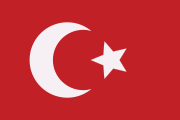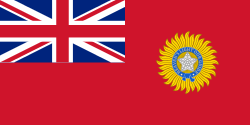Order of the Crown (Prussia)


The Order of the Crown (German: Kronenorden) was Prussia's lowest ranking order of chivalry. Instituted in 1861 as an award equal in rank to the Order of the Red Eagle, it could only be awarded to commissioned officers (or civilians of approximately equivalent status), but there was a medal associated with the order which could be earned by non-commissioned officers and enlisted men.
Officially the Order of the Red Eagle and the Order of the Crown were equal. Most officials did however prefer to be appointed in the senior Order of the Red Eagle. The Order of the Crown was often used as a decoration of someone who had to be rewarded while the Prussian government did not want to award the Order of the Red Eagle.[1]
The Order had six classes:
- Grand Cross - wore the Grand Cross badge on a sash on the right shoulder, plus the star on the left chest;
- 1st Class - wore the badge on a sash on the right shoulder, plus the star on the left chest;
- 2nd Class - wore the badge on a necklet, plus the star on the left chest;
- 3rd Class - wore the badge on a ribbon on the left chest;
- 4th Class - wore the badge on a ribbon on the left chest;
- Medal - wore the medal on a ribbon on the left chest.
Insignia
The badge of the Order for the 1st to 4th classes was a gilt cross pattée, with white enamel (except for the 4th Class, which was plain). The obverse gilt central disc bore the crown of Prussia, surrounded by a blue enamel ring bearing the motto of the German Empire Gott Mit Uns (God With Us). The reverse gilt disc has the Prussian royal monogram, surrounded by a blue enamel ring with the date 18 October 1861.
The star of the Order was (for Grand Cross) a gilt eight-pointed star, (for 1st Class) a silver eight-pointed star, or (for 2nd Class) a silver four-pointed star, all with straight rays. The gilt central disc again bore the crown of Prussia, surrounded by a blue enamel ring bearing the motto Gott Mit Uns.
The ribbon of the Order was blue.
The order could be awarded in dozens of variations. For example with superimposed Cross of Geneva (Red Cross - normally given to doctors for meritorious service), with swords and with oak leaves.
List of Knights
The following lists show a fair cross section of individuals who were known to be conferred with the Order in its several classes, in order of precedence. (The following is only a partial list and may expand over time, with further research.)
-
 Sir Christopher George Francis Maurice Cradock
Sir Christopher George Francis Maurice Cradock -
 Mustafa Kemal Atatürk - 1st Class
Mustafa Kemal Atatürk - 1st Class - Ernst von Bibra - 3rd Class 1869
- Gen. Flaviano Paliza - 2nd Class 1899
-
 Robert James Lindsay VC KCB, 1st and last Baron Wantage of Lockinge - 3rd Class with Cross of Geneva (Following Franco-Prussian War awarded for work with British National Society for Aid to the Sick and Wounded in War)
Robert James Lindsay VC KCB, 1st and last Baron Wantage of Lockinge - 3rd Class with Cross of Geneva (Following Franco-Prussian War awarded for work with British National Society for Aid to the Sick and Wounded in War) -
 Jagatjit Singh of Kapurthala - 1st Class 1911
Jagatjit Singh of Kapurthala - 1st Class 1911 - Friedrich Wilhelm von Lindeiner-Wildau - 4th Class with Swords
-
 Sir James Reid, 1st Baronet - 2nd class 1901
Sir James Reid, 1st Baronet - 2nd class 1901 -
 Lieutenant-Colonel Sir James Grierson, British Military Attaché at Berlin - 1st class 1901[2] (previously 2nd class)
Lieutenant-Colonel Sir James Grierson, British Military Attaché at Berlin - 1st class 1901[2] (previously 2nd class) -
 Sir William Carington, Comptroller and Treasurer to the Prince of Wales - 2nd class, with star, January 1902 - during the visit to Berlin of the Prince for the birthday of Emperor Wilhelm II[3]
Sir William Carington, Comptroller and Treasurer to the Prince of Wales - 2nd class, with star, January 1902 - during the visit to Berlin of the Prince for the birthday of Emperor Wilhelm II[3] -
 Sir Charles Cust, Equerry to the Prince of Wales - 2nd class, January 1902 - during the visit to Berlin of the Prince for the birthday of Emperor Wilhelm II[3]
Sir Charles Cust, Equerry to the Prince of Wales - 2nd class, January 1902 - during the visit to Berlin of the Prince for the birthday of Emperor Wilhelm II[3] -
 Lieutenant-Colonel James Robert Johnstone - 2nd class, May 1902 - in recognition of his services in China during the Boxer Rebellion.[4]
Lieutenant-Colonel James Robert Johnstone - 2nd class, May 1902 - in recognition of his services in China during the Boxer Rebellion.[4]
References
- ↑ "Der Kronenorden 1.Modell". Medalnet.net. 2004-03-04. Retrieved 2013-05-24.
- ↑ The London Gazette: no. 27393. p. 1. 3 January 1902.
- ↑ 3.0 3.1 "Court circular" The Times (London). Saturday, 8 February 1902. (36686), p. 9.
- ↑ "Court Circular" The Times (London). Saturday, 17 May 1902. (36770), p. 8.
| ||||||||||||||||